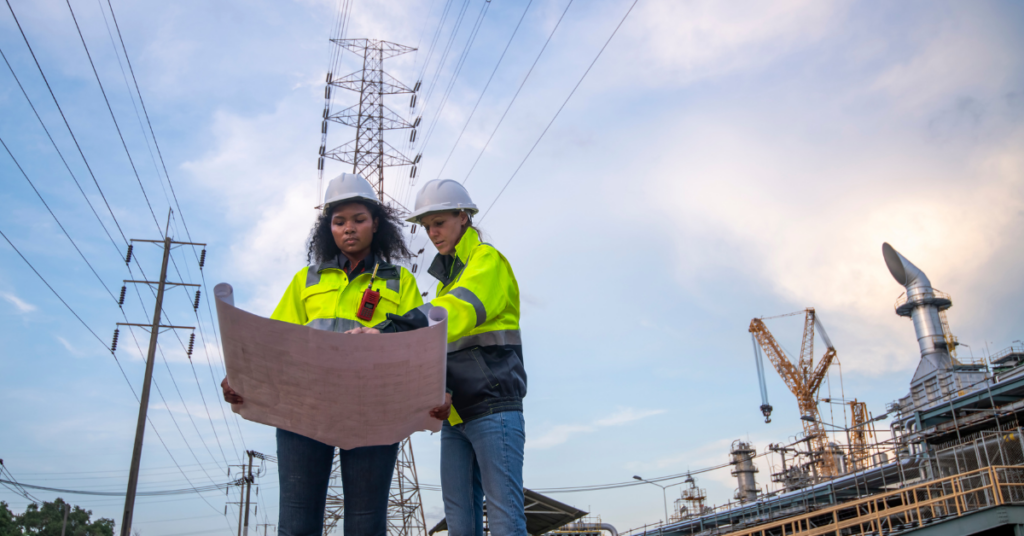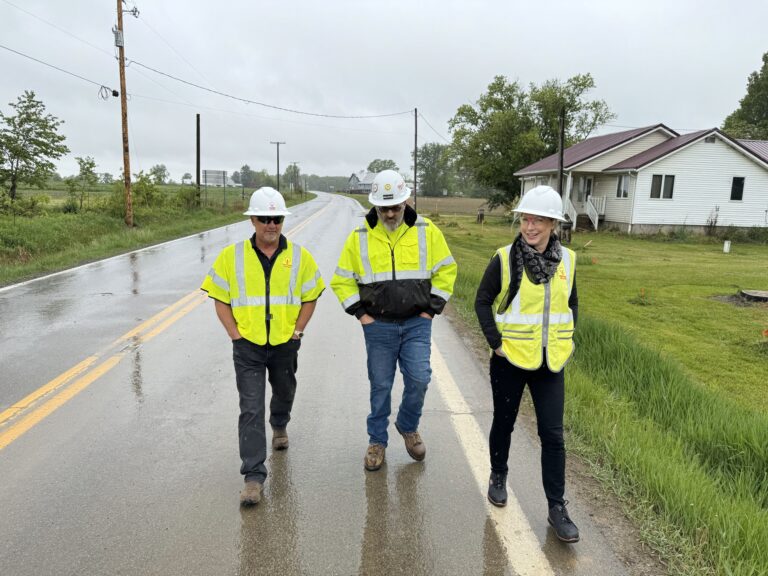Overcoming permitting challenges in utility infrastructure projects is a critical step in ensuring the timely delivery of essential infrastructure, such as transmission lines, substations, and water systems. For utility project managers and engineers in the US, securing permits from local, state, and federal agencies involves navigating a complex web of environmental, safety, and zoning regulations. These projects are vital for maintaining grid reliability and meeting growing energy demands, but permitting delays can halt progress, inflate costs, and disrupt schedules, ultimately affecting communities that rely on consistent power and resources.
Strategies to Overcome Permitting Challenges in Utility Infrastructure Projects
Navigating the permitting process for utility infrastructure projects requires a strategic approach to minimize delays and ensure compliance. Below are several key strategies to streamline the process and keep your project on track:
Digital Permitting Platforms
The adoption of digital permitting platforms can significantly reduce administrative delays. These online systems allow for electronic submission of applications and documentation, providing real-time access to all necessary materials. By centralizing the process, digital platforms eliminate the inefficiencies of paper-based systems, such as lost documents or manual errors, enabling faster reviews and approvals from regulatory agencies.
Advanced Mapping and Drones
Accurate environmental assessments are a cornerstone of the permitting process, particularly for projects that require Environmental Impact Assessments (EIAs). Leveraging advanced mapping technologies like Geographic Information Systems (GIS) and drones can enhance the quality of these assessments. Drones provide detailed aerial photography and data, while GIS offers precise mapping of project sites, helping to identify potential environmental concerns early. This approach can reduce review times by providing regulators with comprehensive, visually supported documentation.
AI for Compliance Tracking
Artificial intelligence (AI) can play a pivotal role in ensuring regulatory compliance during the permitting process. AI tools can automate the review of documentation, flagging potential gaps or inconsistencies before submission. This proactive approach helps project teams address issues early, reducing the likelihood of rejections or requests for additional information from regulators. By streamlining compliance tracking, AI can save time and resources, keeping the permitting process on schedule.
Community Engagement
Local opposition is a common hurdle in utility projects, particularly when it comes to siting new infrastructure. Engaging with communities early in the process through public consultations can help address concerns and build support. Transparency about the project’s benefits, such as improved energy reliability or job creation, can mitigate resistance. By fostering trust and collaboration, community engagement can expedite approvals and reduce the risk of legal challenges that delay permitting.
Coordination with Regulators
Effective communication with regulatory agencies is essential for a smooth permitting process. Establishing clear channels with bodies like the Federal Energy Regulatory Commission (FERC) or state environmental agencies ensures that project plans align with regulatory expectations. Regular updates and pre-submission meetings can help clarify requirements, address potential issues, and expedite reviews. This coordination minimizes miscommunication and ensures that all parties are on the same page throughout the process.
Here’s a summary of these strategies in a table for clarity:
| Strategy | Description | Benefit |
| Digital Permitting Platforms | Use online systems for electronic submission of applications and documentation. | Speeds up approvals, reduces administrative delays. |
| Advanced Mapping and Drones | Leverage GIS and drones for accurate environmental assessments and visual data. | Enhances EIAs, reduces review times. |
| AI for Compliance Tracking | Use AI to automate documentation checks and ensure regulatory compliance. | Proactively identifies gaps, avoids delays. |
| Community Engagement | Conduct public consultations to address local concerns and build support. | Reduces opposition, expedites approvals. |
| Coordination with Regulators | Establish clear communication channels with regulatory agencies for faster reviews. | Aligns plans with expectations, minimizes miscommunication. |
Analyzing Key Permitting Challenges
Permitting challenges can significantly impact utility infrastructure projects, often leading to delays and increased costs. A deeper understanding of these issues is essential for developing effective solutions.
Local Opposition and Restrictive Ordinances
One of the most significant challenges in permitting is local opposition, often driven by concerns over land use, environmental impact, or aesthetic changes. In many regions, restrictive local ordinances can limit where projects can be sited, particularly for renewable energy initiatives like wind or solar farms. This opposition can lead to prolonged public hearings, legal challenges, or the need to redesign projects, all of which delay timelines and increase expenses. Addressing this challenge requires a proactive approach to community engagement and a thorough understanding of local regulations.
Navigating Environmental Regulations
Utility projects must comply with stringent environmental regulations, such as those under the Endangered Species Act (ESA) or the National Environmental Policy Act (NEPA). These laws often require extensive EIAs to assess the project’s impact on wildlife, water resources, and air quality. Preparing these assessments can be resource-intensive, involving detailed studies and consultations with environmental experts. The review process for EIAs can stretch timelines, especially for large-scale projects like offshore wind farms or cross-state transmission lines, where multiple ecosystems are affected. This complexity underscores the need for accurate data and early planning to meet regulatory requirements.
Lengthy and Complex Processes
The permitting process for utility projects is often lengthy and bureaucratic, involving multiple stages such as feasibility studies, public consultations, and approvals from various agencies. For instance, projects requiring federal oversight, such as interstate transmission lines, may need permits from FERC, the Department of Energy (DOE), and state-level agencies. Each stage can take months or even years, particularly if additional information is requested or if there are discrepancies in the application. These delays can disrupt project schedules, increase holding costs, and affect the overall feasibility of the initiative, making it critical to streamline the process wherever possible.
Coordination Among Stakeholders
Utility projects involve multiple stakeholders, including project developers, contractors, local governments, and regulatory agencies. Coordinating among these parties can be challenging, especially when priorities or expectations differ. Miscommunication can lead to conflicts, such as disagreements over project scope or compliance requirements, which can halt progress until resolved. For example, a lack of alignment between a developer and a state environmental agency on mitigation measures can result in repeated revisions to the application, further delaying approvals. Effective coordination and clear communication are essential to avoid these setbacks.
Future Trends in Permitting
Emerging trends are poised to reshape the permitting landscape for utility infrastructure projects, offering opportunities to improve efficiency while presenting new challenges to consider.
Permitting Reforms in Utility Infrastructure Projects
Federal and state governments are increasingly focused on reforming the permitting process to accelerate infrastructure development. Legislation like the Infrastructure Investment and Jobs Act and the Inflation Reduction Act has introduced measures to expedite approvals, such as fast-tracking certain clean energy projects. While these reforms aim to reduce delays, they must balance speed with environmental oversight. Resistance from environmental groups or local communities concerned about oversight may slow implementation, requiring careful navigation to ensure reforms achieve their intended impact.
Technology Adoption
Technology is transforming the permitting process, with tools like digital platforms, AI, and drones becoming more prevalent. Digital platforms streamline submissions, AI ensures compliance, and drones enhance environmental assessments, all of which can reduce review times. However, adopting these technologies requires significant investment in infrastructure and training. Additionally, some regulatory agencies may resist moving away from traditional methods, creating a barrier to widespread adoption. The cost-effectiveness of these tools will depend on their ability to scale across diverse projects and jurisdictions.
Sustainability in Permitting
Sustainability is becoming a key consideration in permitting, with regulators increasingly requiring eco-friendly designs and practices. For utility projects, this might mean incorporating renewable materials, minimizing land disturbance, or implementing carbon offset programs. While these requirements align with broader environmental goals, they can add complexity to the permitting process, as projects must demonstrate compliance with additional standards. Balancing sustainability with project timelines and budgets is a challenge, but it also presents an opportunity to innovate and align with evolving regulatory expectations.
Building a Foundation for Success in Utility Projects
Overcoming permitting challenges is essential for the success of utility infrastructure projects, ensuring that critical systems are delivered efficiently and reliably. By adopting strategies like digital permitting platforms, leveraging technology for compliance, engaging communities, and coordinating with regulators, utility professionals can navigate the permitting process more effectively. Addressing challenges such as local opposition, environmental regulations, lengthy processes, and stakeholder coordination requires careful planning and proactive measures. Staying ahead of trends like permitting reforms, technology adoption, and sustainability can further enhance your approach, positioning your projects for long-term success.
For utility project managers and engineers in the US, mastering these strategies is key to delivering infrastructure that powers communities and supports the nation’s energy needs. At Think Power Solutions, we understand the complexities of permitting in the utility sector, and we’re here to provide the expertise you need to succeed.



